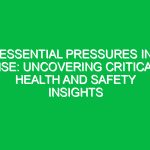Introduction
In today’s fast-paced world, the importance of Personal Protective Equipment (PPE) cannot be overstated, especially within the Health, Safety, and Environment (HSE) domain. But what exactly are PPE? These are specialized tools and gear designed to safeguard individuals from potential Hazards in the workplace, particularly those that could harm their health or Safety. The relevance of PPE in HSE extends beyond mere compliance with Regulations; it is a critical component of a robust Safety culture that prioritizes the well-being of workers and the environment.
The use of PPE is not merely a checkbox on a safety compliance list; it is a proactive approach to risk management. Whether you’re working in construction, healthcare, or any environment where Hazards are present, understanding what are PPE and how to use them effectively can mean the difference between safety and disaster. This article explores the essentials of PPE, their significance within HSE, and how you can protect yourself now.
What Are PPE?
PPE encompasses a range of safety equipment designed to protect individuals from various risks. These risks can include physical hazards, chemical exposure, biological threats, and environmental dangers. Common Types of PPE include:
- Head Protection: Hard hats and helmets designed to protect against falling objects.
- Eye Protection: Safety Goggles and face shields that guard against flying debris and harmful chemicals.
- Hearing Protection: Earplugs and earmuffs that reduce noise exposure in loud environments.
- Respiratory Protection: Masks and respirators that filter out harmful airborne particles.
- Hand Protection: Gloves designed for various tasks to protect against cuts, burns, and chemical exposure.
- Foot Protection: Steel-toed boots and slip-resistant shoes to prevent foot injuries.
- Body Protection: Coveralls, vests, and aprons that shield the body from hazardous materials.
The Importance of PPE in HSE
Understanding what are PPE is crucial, but recognizing their importance in the HSE context is equally vital. PPE plays a significant role in:
1. Reducing Workplace Injuries
Statistics reveal that many workplace injuries can be prevented through the proper use of PPE. For instance, in construction, a significant percentage of injuries result from falls or being struck by objects. Wearing appropriate head and foot protection can mitigate these risks substantially.
2. Complying with Regulations
Various safety regulations mandate the use of PPE in specific industries. In the U.S., the Occupational Safety and Health Administration (OSHA) sets forth Standards that require employers to provide appropriate PPE for their employees. Non-compliance can lead to severe penalties and increased liability.
3. Enhancing Workplace Morale
When employees see that their employer prioritizes their safety by providing the necessary PPE, it fosters a culture of care and respect. This, in turn, can lead to increased job satisfaction and productivity.
Key Components of Effective PPE
To ensure the effectiveness of PPE, several key components must be considered:
1. Proper Fit
One of the most critical aspects of PPE is ensuring that it fits correctly. Ill-fitting equipment can compromise safety and comfort. For example, safety goggles that do not seal properly can allow harmful particles to enter, rendering them ineffective.
2. Maintenance and Care
PPE must be well-maintained to ensure optimal performance. Regular inspections for wear and tear are essential. For example, a worn-out harness may fail during a fall, leading to severe injuries or fatalities. Keeping a log of PPE Maintenance can help track its condition and ensure safety standards are met.
3. Training and Awareness
Merely providing PPE is not enough; training employees on its proper use is crucial. Workers need to understand how to wear, maintain, and recognize when PPE is no longer functional. This Training can be the difference between life and death in hazardous environments.
Potential Hazards and Risks
Understanding what are PPE involves recognizing the various hazards that necessitate their use. Some common hazards include:
1. Chemical Exposure
Workers in chemical manufacturing or laboratory settings face risks from spills, splashes, and toxic fumes. In these environments, appropriate gloves, goggles, and respirators are essential to minimize exposure.
2. Physical Hazards
Construction sites present various physical hazards, including falling objects and sharp tools. Wearing hard hats, steel-toed boots, and cut-resistant gloves can significantly reduce the risk of injury.
3. Biological Hazards
Healthcare workers are often exposed to biological hazards, including viruses and bacteria. In these situations, masks, gloves, and gowns are critical for protecting against infection.
Best Practices for PPE Implementation
To maximize the effectiveness of PPE in the workplace, consider the following Best Practices:
1. Conduct a Hazard Assessment
Before selecting PPE, conduct a thorough hazard assessment to identify potential risks in the workplace. This assessment should include evaluating tasks, materials, and environmental conditions.
2. Involve Employees in the Process
Involving employees in the selection of PPE can increase compliance and comfort. Workers can provide valuable insights into what feels comfortable and functional for their specific tasks.
3. Regularly Update PPE Training
PPE training should not be a one-time event. Regular refresher courses can help keep safety protocols top of mind and ensure that employees remain aware of any changes in equipment or Procedures.
Regulations and Standards Governing PPE
Various regulations and standards govern the use of PPE. Familiarizing yourself with these requirements is essential for compliance and safety:
1. osha Standards
In the United States, OSHA’s standards require employers to assess workplace hazards and provide necessary PPE. Employers must also train employees on the proper use of PPE. Non-compliance can lead to hefty fines and increased liability.
2. ANSI Standards
The American National Standards Institute (ANSI) has established standards for different types of PPE. These standards ensure that PPE meets specific performance criteria, ensuring that equipment is reliable and effective.
3. International Regulations
Globally, various organizations, such as the International Organization for Standardization (ISO), have established guidelines for PPE. Understanding these international standards can be beneficial for organizations operating in multiple countries.
Conclusion
In conclusion, understanding what are PPE and their critical role in the Health, Safety, and Environment (HSE) domain is imperative for everyone. From reducing workplace injuries to complying with regulations, the importance of PPE cannot be overstated. By prioritizing proper fit, maintenance, and training, organizations can significantly enhance Workplace Safety.
As we navigate through increasingly complex work environments, the need for effective PPE becomes more pronounced. Protecting yourself and your colleagues is not just a responsibility; it is a commitment to a safer and healthier workplace. Remember, in the world of HSE, your safety is paramount—take action, invest in proper PPE, and foster a culture of safety. Protect yourself now, because safety is not just a choice; it is a necessity.


